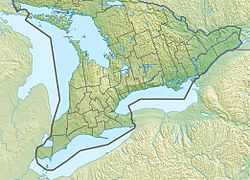| Baitul Islam Mosque | |
|---|---|
 | |
| Religion | |
| Affiliation | Ahmadiyya Islam |
| Ecclesiastical or organizational status | Mosque |
| Status | Active |
| Location | |
| Location | Vaughan, Greater Toronto, Ontario |
| Country | Canada |
Location in southern Ontario | |
| Geographic coordinates | 43°51′53.58″N79°32′34.66″W / 43.8648833°N 79.5429611°W |
| Architecture | |
| Architect | Gulzar Haider |
| Type | Mosque architecture |
| Completed | 1992 |
| Specifications | |
| Dome | 2 |
| Minaret | 1 |
| Website | |
| ahmadiyya | |
The Baitul Islam Mosque (House of Islam) is an Ahmadiyya mosque in Vaughan, in the Greater Toronto area of Ontario, Canada. The mosque is run by the Ahmadiyya Muslim Community Canada. The mosque was inaugurated on October 17, 1992 in the presence of the fourth Caliph of the community and many Members of Parliament. [1]
